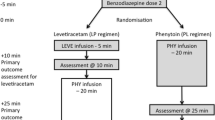Abstract
Purpose To compare the effect of rectally administered diazepam and chloral hydrate on serial seizures or status epilepticus. Methods In an open prospective pilot study we compared the rectal administration of diazepam (0.4 mg/kg body weight) with a 20% solution of chloral hydrate (50mg/kg) inpatients of an epilepsy hospital with serial seizures or status epilepticus (grand mal-seizures excluded). Outcome criteria were defined as absence of seizures during the next 3 and 24 hours following administration of the study drug, as well as eventual necessity of an additional intervention in case of recurrent seizures. Results Analysis of 69 interventions (chloral hydrate, 32 and diazepam, 37) in 65 episodes of serial seizures and 4 episodes of status epilepticus showed no recurrence of seizures within 3 hours and within 24 hours in 78% and 41% of patients treated with diazepam compared to 72% and 48% of patients treated with chloral hydrate (p=0.58 and 0.81). After application of diazepam or chloral hydrate, additional intervention due to recurrent seizures was necessary in 14% and 22% respectively (p=0.53). Conclusions These results indicate comparable efficacy of both drugs. Chloral hydrate seems to be a useful alternative to diazepam in the treatment of serial seizures.
Zusammenfassung
Fragestellung Vergleich der Wirksamkeit einer rektalen Behandlung von Anfallsserien und Status epileptici (Grand-mal-Anfälle ausgeschlossen) mit Chloralhydrat oder Diazepam. Methoden In einer offenen, prospektiven Pilotstudie verglichen wir rektal apliziertes Diazepam (0,4 mg/kg Körpergewicht) gegen eine 20% Chloralhydratlösung (50mg/kg) bei stationären Patienten der Klinik Mara I des Epilepsiezentrums Bethel. Zielkriterien waren Anfallsfreiheit über die nächsten 3 und 24 Stunden sowie die Notwendigkeit einer weiteren Intervention in diesem Zeitraum. Ergebnisse Es konnten 69 Interventionen (32 mit Chloralhydrat und 37 mit Diazepam) bei 65 Episoden von Anfallsserien und 4 Status epileptici eingeschlossen werden. Anfallsfrei innerhalb der nächsten 3 bzw. 24 Stunden blieben 78 bzw. 41% der mit Diazepam behandelten Patienten verglichen mit 72 bzw. 48% nach Chloralhydratgabe (p=0,58 bzw. 0,81). Eine weitere Intervention wegen erneuter Anfälle war in 14% der Fälle nach Diazepam- und in 22% nach Chloralhydratgabe erforderlich (p=0,53). Schlussfolgerung Die Ergebnisse lassen auf eine vergleichbare Wirksamkeit beider Pharmaka schließen. Damit wäre Chloralhydrat eine sinnvolle Alternative zu Diazepam in dieser Indikation.
Similar content being viewed by others
Author information
Authors and Affiliations
Additional information
Eingegangen: 12. Dezember 2002/Akzeptiert: 14. Januar 2003
Correspondence to:Martin Finzel
Rights and permissions
About this article
Cite this article
Finzel, M., Finzel, M., Specht, U. et al. Chloralhydrat versus Diazepam zur rektalen Behandlung von Anfallsserien und Status epileptici – eine Pilotstudie. Z Epileptol 16, 0144–0150 (2003). https://doi.org/10.1007/s10309-003-0011-y
Issue Date:
DOI: https://doi.org/10.1007/s10309-003-0011-y



